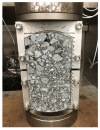Material Optimization and Curing Characterization of Cold-Mix Epoxy Asphalt: Towards Asphalt Overlays for Airport Runways
- PMID: 40808087
- PMCID: PMC12349570
- DOI: 10.3390/polym17152038
Material Optimization and Curing Characterization of Cold-Mix Epoxy Asphalt: Towards Asphalt Overlays for Airport Runways
Abstract
Currently, numerous conventional airport runways suffer from cracking distresses and cannot meet their structural and functional requirements. To address the urgent demand for rapid and durable maintenance of airport runways, this study investigates the material optimization and curing behavior of cold-mix epoxy asphalt (CEA) for non-disruptive overlays. Eight commercial CEAs were examined through tensile and overlay tests to evaluate their strength, toughness, and reflective cracking resistance. Two high-performing formulations (CEA 1 and CEA 8) were selected for further curing characterization using differential scanning calorimetry (DSC) tests, and the non-isothermal curing kinetics were analyzed with different contents of Component C. The results reveal that CEA 1 and CEA 8 were selected as promising formulations with superior toughness and reflective cracking resistance across a wide temperature range. DSC-based curing kinetic analysis shows that the curing reactions follow an autocatalytic mechanism, and activation energy decreases with conversion, confirming a self-accelerating process of CEA. The addition of Component C effectively modified the curing behavior, and CEA 8 with 30% Component C reduced curing time by 60%, enabling traffic reopening within half a day. The curing times were accurately predicted for each type of CEA using curing kinetic models based on autocatalytic and iso-conversional approaches. These findings will provide theoretical and practical guidance for high-performance airport runway overlays, supporting rapid repair, extended service life, and environmental sustainability.
Keywords: airport overlay; cold-mix epoxy asphalt; curing behaviors; differential scanning calorimetry (DSC); non-isothermal curing kinetics.
Conflict of interest statement
The authors declare no conflicts of interest.
Figures














Similar articles
-
Effect of encapsulated waste oils and compaction method on the curing and strength of cold mix asphalt.Sci Rep. 2025 Jul 23;15(1):26687. doi: 10.1038/s41598-025-11506-9. Sci Rep. 2025. PMID: 40695966 Free PMC article.
-
Prescription of Controlled Substances: Benefits and Risks.2025 Jul 6. In: StatPearls [Internet]. Treasure Island (FL): StatPearls Publishing; 2025 Jan–. 2025 Jul 6. In: StatPearls [Internet]. Treasure Island (FL): StatPearls Publishing; 2025 Jan–. PMID: 30726003 Free Books & Documents.
-
A Study on the Road Performance of the Self-Healing Microcapsule for Asphalt Pavement.Materials (Basel). 2025 Jul 25;18(15):3483. doi: 10.3390/ma18153483. Materials (Basel). 2025. PMID: 40805361 Free PMC article.
-
A rapid and systematic review of the clinical effectiveness and cost-effectiveness of topotecan for ovarian cancer.Health Technol Assess. 2001;5(28):1-110. doi: 10.3310/hta5280. Health Technol Assess. 2001. PMID: 11701100
-
Home treatment for mental health problems: a systematic review.Health Technol Assess. 2001;5(15):1-139. doi: 10.3310/hta5150. Health Technol Assess. 2001. PMID: 11532236
References
-
- Xiao F., Ma D., Wang J., Cai D., Lou L., Yuan J. Impacts of high modulus agent and anti-rutting agent on performances of airfield asphalt pavement. Constr. Build. Mater. 2019;204:1–9. doi: 10.1016/j.conbuildmat.2019.01.138. - DOI
-
- Correia N.S., Souza T.R., Silva M.P.S., Kumar V.V. Investigations on interlayer shear strength characteristics of geosynthetic-reinforced asphalt overlay sections at Salvador International Airport. Road Mater. Pavement Des. 2022;24:1542–1558. doi: 10.1080/14680629.2022.2092021. - DOI
-
- Yang R., Zhan C., Sun L., Shi C., Fan Y., Wu Y., Yang J., Liu H. Modelling the reflective cracking features of asphalt overlay for airport runway under temperature and airplane load coupling factors. Constr. Build. Mater. 2024;451:138774. doi: 10.1016/j.conbuildmat.2024.138774. - DOI
-
- Zaini A.A., Aziz M.M.A., Kassim K.A., Mustafa K.H. A Review on Crack Relief Layer in Airport Runway. J. Teknol. 2016;78:41–48. doi: 10.11113/jt.v78.9477. - DOI
-
- Fan Y., Yu Y., Shi C., Wu Y., Huang S., Zhou Y., Wang H., Yang J., Huang W. Failure modes of asphalt pavement with top-down cracks based on measured aging gradients in field cores. Constr. Build. Mater. 2024;438:137050. doi: 10.1016/j.conbuildmat.2024.137050. - DOI
Grants and funding
LinkOut - more resources
Full Text Sources

